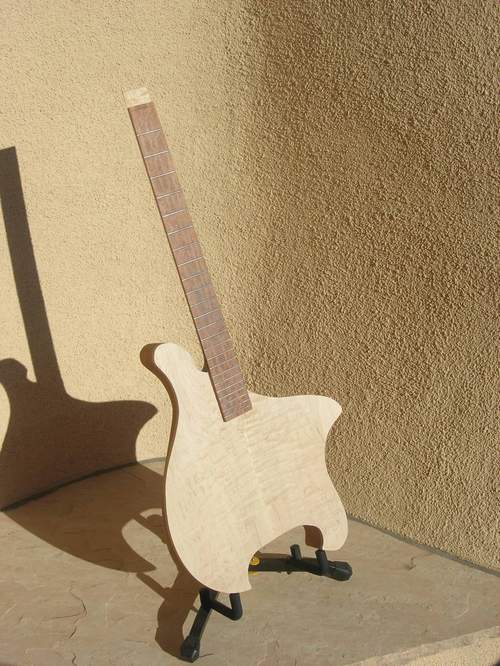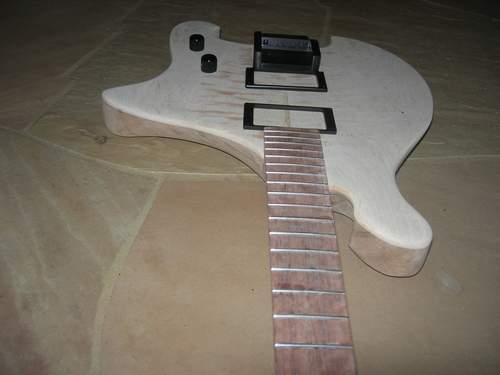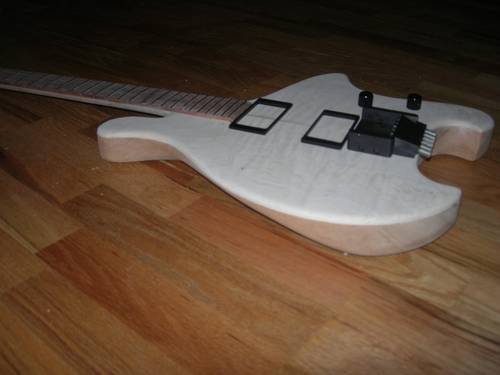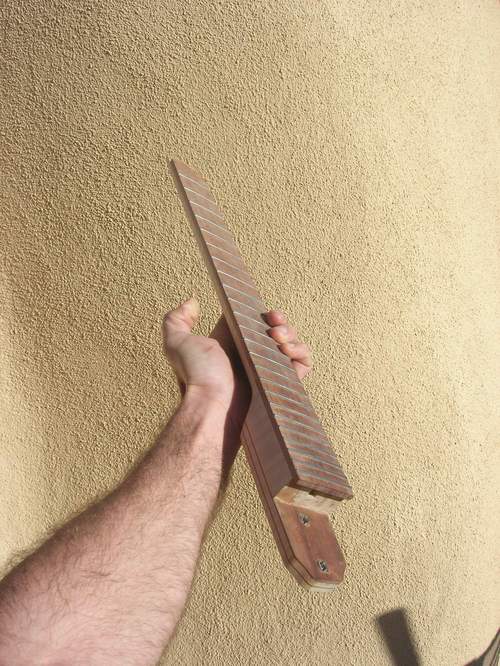Canton Custom Guitars Design #2
In Canton Custom Guitars – Three New Models, we saw electric guitar templates Rick Canton had worked up for several designs. Rick has been hard at work on Model #2 and shared the following…
Guitar Body
The chambered goncalo alves guitar body has changed a bit but it’s still clearly Model #2 from the original article. It’s paired up with a bookmatched curly maple top:

These next two shots give you an idea of the body contouring.
First a view from the neck:

Next a side view:

Extended Heel Neck
The Canton guitar neck includes several interesting features including a 4 bolt extended heel design that reaches far into the guitar body.

And here are its specs:
- Curly maple with rosewood/curly maple heel laminates
- Figured bubinga 25.5″ scale fretboard with 20″ radius
- Zero fret – stainless steel jumbo
- Frets 1-16 – stainless steel medium
- Frets 17-24 – stainless steel small
- 2 graphite stabilizer bars
- 2 way truss rod
- Steinberger top load headpiece
Note the use of three different sized frets which Rick describes as follows:
The 2 (actually intentionally 3 with the jumbo -0- fret) allows for lower action. There is also a feeling of “more room” when holding a chord or running a scale at the higher registers with the fret layout.
I also sanded the fretboard’s 20″ radius thinner at the higher registers. The fretboards thickness goes from 1/4″ at the -0-n fret evenly tapering to just over 1/8″ at the 24th fret. This, coupled with the fret sizes, allows for closer action.
Bridge and Electronics
Rick will be using the Bondy hardtail bridge. You can read more about it in Owner Feedback on the Bondy Guitar Bridge.
Electronics and circuit layout are TBD but the pickups will be some type of humbucker.
More to follow so stay tuned…
Well alright! That’s looking really interesting. I would like to learn the thinking behind your wood choices – the chambered goncalo alves body and bubinga fretboard. These are both unique choices, so please explain if you have a method to your madness. 🙂
Woah! Can I say it… that’s actually sexy 🙂
Great looking guitar, what would one of these cost?
@Steven – You sure can say it! Let’s just keep it “family friendly” . 😀
@Roger, Steven –
Sounds like we’ll need to drag Rick away from his work for a bit to answer some questions.
Rick, the contouring on the body is just beautiful!
Ok!This is good project..Ä° try 26,771654”scale (68cm)with my Steinberger electric guitar.Fretboard is ebony.This is other sound.More sustain,more bass,not crisp or not fat.Agressive and very louder.The scale is good for fusion sounds.Ä° see 68 scale,birdseye maple fretboard is good for this project.Thank you…………..
Hey BTEG,Roger,Steven,Robert,Al & Burcin,
Thank you for the kind words, it is always a good feeling to do what you love to do and hear positive feedback.
This model is a prototype, I wanted to 1: see how things felt with the geometry of the shape/size etc. of this design, 2: test out the chambering and the goncalo alves specifically( I have heard only good things with goncalo alves, but, it is a heavy wood) 3: test various pickups and a tone circuit design I`ve been thinking about 4: see what else may need to change for a future model.
You can see by comparing the template version of this to how it stands today that I leaned towards modifying it`s shape a bit. I felt the cut out in the bass side horn was needed, I then created a steep contouring and a thumb rest behind frets 18 & 19 for easier access to the higher registers.
I have since rounded the edges over and fine shaped more of the overall contouring. I will be sending Robert new pictures by Sunday pm as an update.
This prototype probably will not be sold as it is an experiment and I am not totally happy with its unfolding right now. As far as Steve`s inquiry of price, feel free to e-mail me at: cantonguitars@gmail.com
On a separate note: Look forward to Al Shaffers custom ergo,(Picture #1 of the templates) there will be pics sent to Robert over the next few weeks of the neck. We have chosen very beautiful pieces of waterfall bubinga and figured purpleheart for the neck. Al has a very deep creative side (check out The Three Halos on Youtube) and I am very enthused with the creation process of his guitar.
I also want to thank Robert for his excellent work with this blog/site, not only is it a place of blossoming new creativity, it is a possible solution for health problems guitarist may face.
Enjoy creating,
Rick
I like it very very much. The fact that you have major jumbo size ss fret as zero fret, and then medium SS frets to the 16th and then smallest size ss frets makes for some REALLY intriguing feature. Ergonomics that is.
I do think, however, that as sustain lessens as you move UP the neck, you need all there is to keep sustain, so maybe the reverse direction would even out sustain? Smaller frets at the first frets and thicker higher up? I know, it would feel VERY peculiar to play, but it would even out the sustain. Also I find it easier to bend on thicker fret wire, and a lot of bends – at least when I play – takes place up there, and not so much beneath the 10th fret.
On a bass though, it would be interesting because there’s not much bending going on, but on the other side, there’s plenty of room for any finger anyway up at 22-24th fret on any bass.
Nevertheless, a very intriguing, and clever idea, with different fret wire.
I had an idea a while a go in similar direction on a bass only, BUT that the taper of thick-to-small fretwire should go across the strings instead, so that the thin strings (plain) had more fretwire to them and higher up above the fretboard, and they narrowed down to small narrow and low type banjo frets at the thick E-string. I e fret height should follow string gauge accordingly. But having scrutinized all tooling and eventual methods for this, it turned out insurmountable. At least to a DIY luthier like myself. The reason for this was that I wanted the bottom of all strings to have the same distance down to the frets everywhere. So that the top of all strings could be levelled, leaving a more flat “radius” across all strings, making fingering easier. Also the low strings are more prone to slight pitch shift, from higher frets, than high strings, so they would be more stable when nailed down to a more narrower and lower frets shape. The highest string would have some “air” underneath them while fretted, but there’s more tolerance there, as they’re not so prone to pitch shifting.
On a guitar this wouldn’t work as the plain G-string will be the one most sloppy and prone to pitch shift. That’s the easiest one to make bends on.
Hey Matts,
You wrote:
“I do think, however, that as sustain lessens as you move UP the neck, you need all there is to keep sustain, so maybe the reverse direction would even out sustain? Smaller frets at the first frets and thicker higher up? ”
–
I am a full believer in “-anything- that is on the guitar has an effect on tone/sustain” and ” -everything- affects everything else on the guitar.
Given that, in your example above the effect on sustain would be minimal -but- this is where the “everything else” belief comes in. In a microscopic sense, the “fix” for any sustain loss can be helped or balanced out, somewhere else IMO. In this case, the neck heel design theoretically will balance out any lack of sustain issues from areas that may take away sustain/tone transfer.
I also left in mass in certain areas for the chambering to keep balanced “sized” notes, ie. not too thin sounding treble strings and not too boomy bass strings. I`m looking forward to hearing the results with this prototype.
–
Also you wrote about your fret ideas, I would suggest to look at the fretboard geometry, instead of the frets, to create the same result with your unique idea.
Regards,
Rick
@Rick, agreed. There’s lot more to it than just frets, and your neck heel design may very well contribute to that sort of thing.
Just as I said “you need all there is to keep sustain” which may include everything else too.
–
And my fret ideas, yes, I’ve thought about slightly slanting the fretboard instead and keeping the nut leveles accordingly to produces the same results, towards the thicker strings, but then the fret size would be the same. I want narrower frets as well as they go towards the bottom strings. But this was on bass only. On guitar I see absolutely no benefits to this, since one have to deal with – by and large – an unwound G-string that is floppy and sloppy – always.